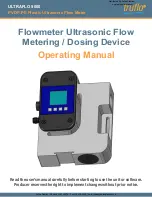
14
EN
Contamination
Abluent
Inorganic metal oxide
Dilute acid less than 1mol/L
Organic lipid
Dilute detergent (weak alkaline)
Resin macromolecule
Dilute alcohol, acetone, ether
Proteinic haematocyte sediment
Acidic enzymatic solution (saccharated yeast tablets)
Paint
Dilute bleacher, peroxide
Note: if the electrode housing is polycarbonate. When use abluent, take cautions on carbon tetrachloride,
trichlorethylene, tetrahydrofuran, acetone, etc which will dissolve the housing and invalidate the electrode.
mV measurement
Press
key,
and
switch
the
meter
to
mV
measurement
mode.
Connect ORP electrode (need purchase it separately) and dip it in sample solution, stir the solution gently and
leave It solution until
icon appears, and get the reading which is ORP value.
ORP means Oxidation Reduction Potential. The unit is mV.
ORP
ORP measurement does not require calibration. When the user is not sure about ORP electrode quality or
measuring value, use ORP standard solution to test mV value and see whether ORP electrode or meter works
properly.
Clean and activate ORP electrode
After the electrode has been used over long period of time, the platinum surface will get polluted which causes
inaccurate measurement and slow response. Please refer to the following methods to clean and activate ORP
electrode:
•
For inorganic pollutant, submerge the electrode in 0.1mol/L dilute hydrochloric acid for 30 minutes, then
wash it in pure water, then submerge it in the soaking solution for 6 hours.
•
For organic or lipid pollutant, clean the platinum surface with detergent, then wash it in pure water, then
submerge it in the soaking solution for 6 hours.
•
For heavily polluted platinum surface on which there is oxidation film, polish the platinum surface with
toothpaste, then wash it in pure water, then submerge it in the soaking solution for 6 hours.
Conductivity
Conductivity cell
Two-ring cells with built-in temperature sensor can be used on this instrument. The conductivity cell uses a BNC
connector while the temperature probe uses an RCA connector. When submerge the conductivity electrode in
solution, stir the solution briefly to eliminate the air bubbles and improve response and stability.
Conductivity cell constant
The meter matches conductivity electrodes of three constants: K=0.1, K=1.0 and K=10.0. Please refer to chart
below for measuring range. Set constant per parameter P2.1.
Summary of Contents for pH 70 Plus
Page 1: ...1 EN ...










































